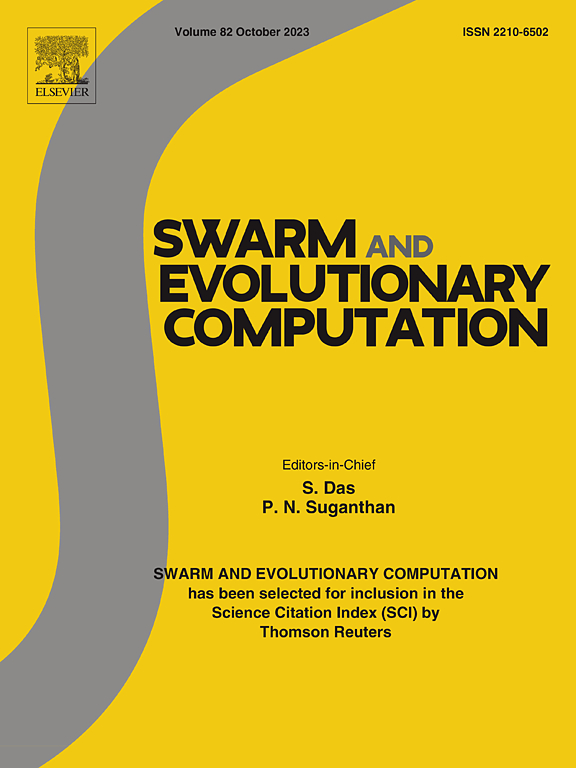基于自适应代理辅助密集加权多目标进化算法的昂贵约束多目标优化
IF 8.5
1区 计算机科学
Q1 COMPUTER SCIENCE, ARTIFICIAL INTELLIGENCE
引用次数: 0
摘要
昂贵约束多目标优化问题(ECMOPs)面临的挑战是如何在有限的昂贵评估范围内有效地获得复杂PF形状的优化结果,并平衡约束优化和目标优化。此外,一个代理通常不能为具有不同特征的多个目标或约束提供一致的预测能力。本文设计了一种自适应代理辅助密集权重多目标进化算法(ASDWMOEA),该算法将高效的基于密集权重的双种群进化与有效的代理切换机制相结合。具体来说,当种群中不存在可行解时,该算法忽略问题的约束,只针对问题的目标使用Kriging代理模型进行优化。当种群进入可行域时,利用外部权值的关联信息进行三次变异操作,生成大量高质量的候选解。然后对每个外部权重进行细化以产生多个内部权重,并选择候选解的一个精英子集来形成与这些内部权重对应的内部总体。随后,对内部种群进行连续的全局和局部搜索,并为每个内部权重选择改进最显著的精英个体。因此,基于两种基于度量的选择策略更新外部种群,并且算法根据外部种群的更新自适应地在所使用的Kriging和RBF代理模型之间切换。最后,使用五个测试套件对17种先进和最新的算法进行了评估。结果表明,ASDWMOEA具有较强的性能。本文章由计算机程序翻译,如有差异,请以英文原文为准。
Expensive constrained multi-objective optimization via adaptive surrogate-assisted dense weight multi-objective evolutionary algorithm
Expensive constrained multi-objective optimization problems (ECMOPs) face challenges in obtaining excellent results for complex PF shapes within limited costly evaluations efficiently and balancing the optimizing on constraints and objectives. Also, one surrogate typically cannot provide the consistent predictive abilities for multiple objectives or constraints with diverse features. This paper designs an adaptive surrogate-assisted dense weight multi-objective evolutionary algorithm (ASDWMOEA), where efficient dense weight-based dual-population evolution and effective surrogate switch mechanism are integrated. Specifically, when there is no feasible solution in the population, the algorithm ignores the constraints of the problem and uses Kriging surrogate model to optimize only for the objective of the problem. When the population enters the feasible domain, the algorithm uses the association information of external weights to implement three mutation operations for generating a large set of high-quality candidate solutions. Each external weight is then refined to produce multiple internal weights, and an elite subset of the candidate solutions is selected to form the internal population corresponding to these internal weights. Subsequently, sequential global and local searches are conducted on the internal population, and the elite individual with the most significant improvement is selected for each internal weight. Hence, the external population is updated based the two metric-based selection strategy, and the algorithm adaptively switches between the employed Kriging and RBF surrogate models based on updates to the external population. Finally, the algorithm is evaluated against seventeen advanced and latest algorithms using five test suites. The results demonstrate that ASDWMOEA exhibits strong performance.
求助全文
通过发布文献求助,成功后即可免费获取论文全文。
去求助
来源期刊

Swarm and Evolutionary Computation
COMPUTER SCIENCE, ARTIFICIAL INTELLIGENCEC-COMPUTER SCIENCE, THEORY & METHODS
CiteScore
16.00
自引率
12.00%
发文量
169
期刊介绍:
Swarm and Evolutionary Computation is a pioneering peer-reviewed journal focused on the latest research and advancements in nature-inspired intelligent computation using swarm and evolutionary algorithms. It covers theoretical, experimental, and practical aspects of these paradigms and their hybrids, promoting interdisciplinary research. The journal prioritizes the publication of high-quality, original articles that push the boundaries of evolutionary computation and swarm intelligence. Additionally, it welcomes survey papers on current topics and novel applications. Topics of interest include but are not limited to: Genetic Algorithms, and Genetic Programming, Evolution Strategies, and Evolutionary Programming, Differential Evolution, Artificial Immune Systems, Particle Swarms, Ant Colony, Bacterial Foraging, Artificial Bees, Fireflies Algorithm, Harmony Search, Artificial Life, Digital Organisms, Estimation of Distribution Algorithms, Stochastic Diffusion Search, Quantum Computing, Nano Computing, Membrane Computing, Human-centric Computing, Hybridization of Algorithms, Memetic Computing, Autonomic Computing, Self-organizing systems, Combinatorial, Discrete, Binary, Constrained, Multi-objective, Multi-modal, Dynamic, and Large-scale Optimization.
 求助内容:
求助内容: 应助结果提醒方式:
应助结果提醒方式:


